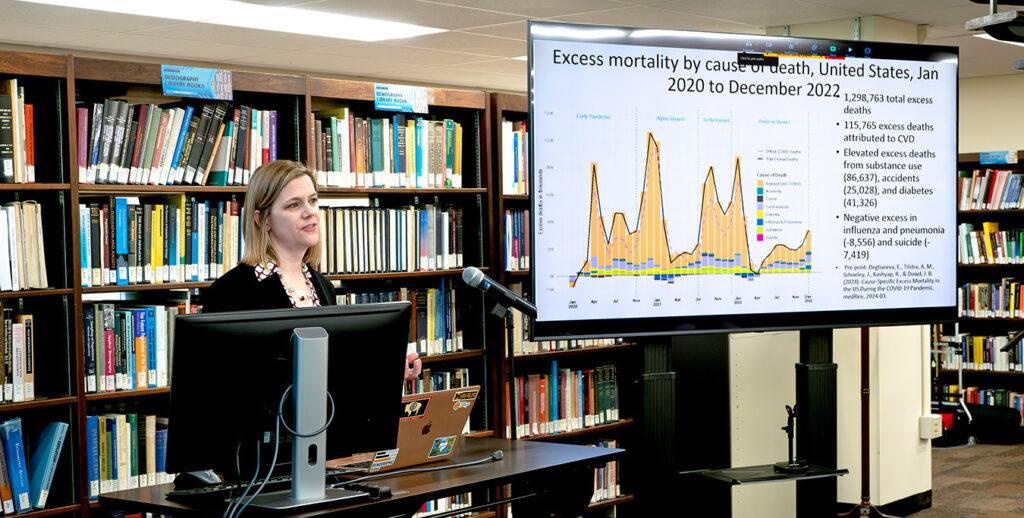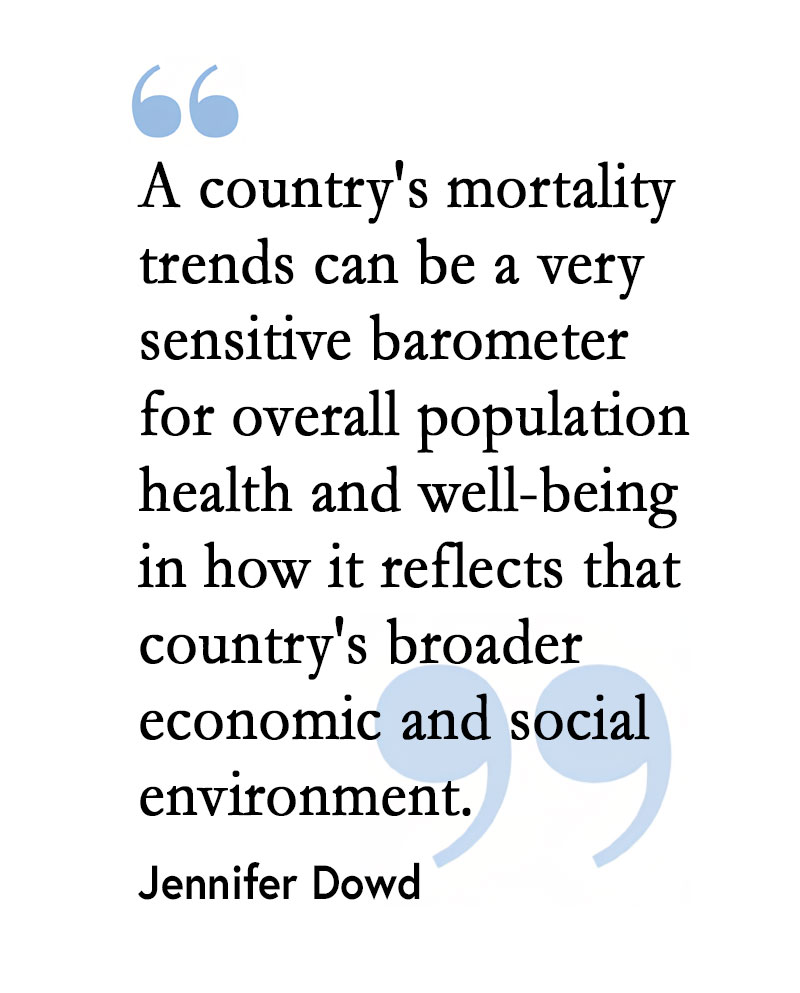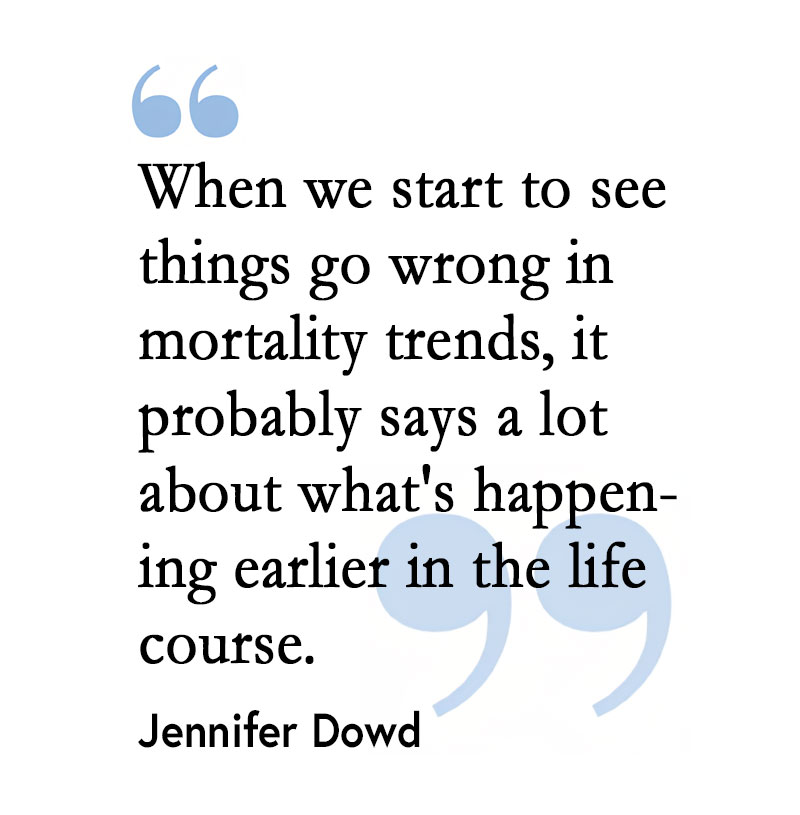
Pennsylvania’s Big Program to Save Rural Hospitals Gets Mixed Financial Reviews
Stable Payments Improved Margins But Not Liquidity, New LDI Analysis Finds
Improving Care for Older Adults
News

ALSO SEE: Companion photo story from the event
In a keynote address at one of the country’s foremost research centers for aging and health, demographer Jennifer Beam Dowd, PhD, emphasized that most people don’t fully appreciate how seemingly dry life expectancy statistics say a lot about a nation’s health and healthcare-related policies and practices. And, she noted, as world rankings of industrialized countries go, the United States is doing worse in that measure than nearly everybody else.

Dowd is Professor of Demography and Population Health and Deputy Director of the Leverhulme Centre for Demographic Science at the University of Oxford. In her address, she spoke about the data and insights from her five-year project funded by the European Research Council (ERC) studying the forces stalling life expectancy gains in the U.S. and UK. She was speaking at the May 3 annual Retreat of the University of Pennsylvania’s Population Aging Research Center (PARC).
“A country’s mortality trends can be a very sensitive barometer for overall population health and well-being in how they reflect that country’s broader economic and social environment,” said Dowd. “When we start to see things go wrong in mortality trends, it probably says a lot about what’s happening earlier in the life course.”
As background, Dowd reminded the audience that the U.S. has witnessed a remarkable increase in life expectancy over the last century, advancing from 47 years in 1900 to 78.9 years in 2014.
The latest data from the Centers for Disease Control and Prevention (CDC) show that life expectancy just before the outbreak of COVID-19 was 78.8 years and dropped to 76.4 years in the second year of the pandemic. It has since risen to 77.5 years. By comparison, life expectancy in the U.K. is 79.0 years, Spain is 83.3 years, Sweden is 83.1 years, and Italy is 82.7 years.
“U.S. life expectancy has been slowing and falling behind its peers’ for quite some time,” Dowd said, noting that this issue is not so much about numbers as it is about the individuals whose early deaths it documents. She pointed to a 2023 “Missing Americans” study co-authored by LDI Senior Fellow Atheendar Venkataramani, MD, PhD, that found that from 1980 to 2019 11 million excess deaths would not have occurred if the U.S. life expectancy rate (or age-standardized mortality rate (ASMR)) had been the same as other wealthy countries. In 1980 the U.S. life expectancy rate began to diverge from that of other peer nations.

A watershed event in this trend occurred in 2015 when U.S. life expectancy declined for the first time in decades. Princeton economists Anne Case and Angus Deaton attributed this to “deaths of despair,” a term they coined to describe the rising mortality rates among middle-aged white Americans due to suicide, drug overdose, and alcohol-related diseases driven by economic hardship, social isolation, and lack of accessible health care.
“The ‘Missing Americans’ idea is just a good reminder that we are really falling short of what we actually know is attainable, because we see it being achieved in other countries,” said Dowd.
In terms of the future of the U.S. population mortality rate, Dowd noted it’s difficult to make predictions, but several continuing population health threats seem to be obvious concerns. These include:
“At the same time as we discuss these pessimistic things, I also want to talk about some reasons for optimism as we look forward,” said Dowd. “In the past new and unexpected breakthroughs in technology have suddenly impacted population health in very positive ways. Right now, we may be looking at one of those with the new anti-obesity medications like Ozempic. It is early days, and we still have a lot to learn about these drugs but the results being seen in clinical trials with weight loss, reductions in cardiovascular deaths, kidney failure, and heart failure seem very promising.”
“But perhaps the best reason to be optimistic is that we have examples of other countries that are doing much better in population health with lower mortality rates,” said Dowd. “We can actually see what is feasible in other human populations and find inspiration in that. That’s why us social scientists need to continue to study these cross-country differences so we can better understand what factors and policies lead to better or worse health outcomes.”
“I like to think about how Eastern Europe suffered a very bad mortality crisis after the fall of the Soviet Union but if you look at their mortality rates now, they’re actually starting to overtake the U.S. in some age groups and performing quite well,” said Dowd. “They are a sign that these mortality crises don’t necessarily last forever, even ones that emerge from dramatic social and economic upheavals. There is always hope that things can get better.”


Stable Payments Improved Margins But Not Liquidity, New LDI Analysis Finds

LDI Senior Fellow Cited for “Significant Contributions” in Research

Outdated Laws Target Black and Queer Lives in Over 30 States, Fueling a Deadly Disease

Selected for Current and Future Research in the Science of Amputee Care

Research Memo: Delivered to House Speaker Mike Johnson and Majority Leader John Thune

Research Memo: Delivered to House Speaker Mike Johnson and Majority Leader John Thune